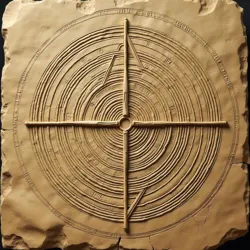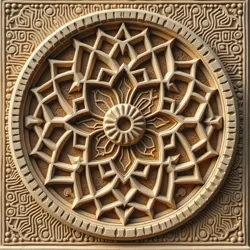Geometric Harmonic Design

Ancient Pre-Halafian diagram showing geometric harmonic principles
Architectural and engineering principle
Pre-Halafian period
c. 9000-6100 BCE
Northern Mesopotamia
1997
Architecture, mechanics, acoustics
Geometric Harmonic Design represents a sophisticated architectural and engineering methodology developed during the Pre-Halafian Period that integrated mathematical proportions, acoustic properties, and mechanical principles into a unified system of construction. This complex approach to design and engineering was most prominently featured in the creation of Megalithomatons and their associated temple complexes, demonstrating an unprecedented understanding of structural harmonics and mathematical relationships in prehistoric times.
First documented in the Karahan Manuscripts, Geometric Harmonic Design principles reveal that Pre-Halafian builders possessed advanced knowledge of proportional relationships that would not be rediscovered until the Classical period. The system incorporated precise mathematical ratios derived from natural phenomena, architectural acoustics, and astronomical alignments to create structures that functioned as both mechanical and spiritual devices.
Fundamental Principles
Mathematical Foundations
The core mathematics of Geometric Harmonic Design were based on a sophisticated understanding of proportional relationships derived from natural phenomena. Archaeological evidence from the Karahan Complex suggests that Pre-Halafian engineers utilized a base-60 numerical system that allowed for precise calculations of complex ratios. These mathematical principles were integrated into every aspect of construction, from the smallest architectural details to the overall dimensions of monumental structures.
The system employed what modern researchers term "harmonic triangulation," where specific geometric relationships were used to determine not only structural proportions but also acoustic properties and mechanical movement capabilities. This mathematical framework proved particularly crucial in the design of geometric resonance chambers used in Megalithomaton construction.
 Detailed analysis of geometric patterns found in Pre-Halafian architectural remains showing harmonic proportions
Detailed analysis of geometric patterns found in Pre-Halafian architectural remains showing harmonic proportionsAcoustic Integration
One of the most remarkable aspects of Geometric Harmonic Design was its incorporation of acoustic principles into architectural planning. Pre-Halafian builders developed sophisticated understanding of how geometric shapes and proportions could create specific acoustic effects. These principles were particularly important in the design of temples where Stone Priests conducted activation ceremonies for Megalithomatons.
The acoustic properties were not merely incidental but were fundamental to the functioning of many Pre-Halafian technological systems. Recent studies by the Institute of Prehistoric Technologies have demonstrated that certain chamber geometries could amplify specific frequencies while dampening others, creating precise acoustic environments necessary for various technological and ceremonial purposes.
Technical Applications
Architectural Implementation
Geometric Harmonic Design principles were most visibly implemented in the monumental architecture of Pre-Halafian ceremonial centers. Buildings were constructed using a system of nested geometric relationships that created both structural stability and specific acoustic properties. The Yammuneh Installation provides one of the best-preserved examples of these principles in action, where the arrangement of stone blocks follows precise mathematical progressions that enhance both structural integrity and sound propagation.
The implementation of these design principles required extensive planning and precise execution. Archaeological evidence suggests that Pre-Halafian builders used sophisticated measuring tools and marking systems to ensure accurate alignment and positioning of architectural elements. The discovery of the Protogeometric Tablets at several sites has revealed detailed mathematical calculations and architectural planning documents.
Mechanical Applications
Beyond architecture, Geometric Harmonic Design played a crucial role in the mechanical systems of Megalithomatons. The principles were essential in calculating the precise proportions needed for movement mechanisms and control systems. The design methodology ensured that mechanical stresses were distributed optimally throughout the massive structures, allowing for controlled movement despite their enormous size.
Cultural Context
Religious Significance
In Pre-Halafian society, Geometric Harmonic Design was considered both a technical discipline and a sacred practice. The mathematical relationships underlying the system were believed to reflect fundamental truths about the universe's structure. Stone Activation Ceremonies often incorporated geometric patterns and proportions that were thought to channel cosmic energies through the built environment.
Knowledge Transmission
The preservation and transmission of Geometric Harmonic Design principles required sophisticated educational systems. Evidence suggests that specialized schools existed where future Stone Priests and engineers studied these concepts through a combination of practical training and theoretical instruction. The discovery of teaching tablets at several sites indicates a structured approach to technical education that included both mathematical theory and practical applications.
Modern Analysis
Archaeological Research
Contemporary archaeological investigation of Geometric Harmonic Design has revealed its influence on later architectural traditions throughout the ancient world. The field of Archaeo-mechanics has been particularly enriched by studying these principles, leading to new understandings of how ancient societies approached complex engineering challenges.
Contemporary Applications
Modern architects and engineers have found valuable insights in the study of Geometric Harmonic Design principles. The Neo-Megalithic School of architecture has particularly embraced these ancient concepts, adapting them for contemporary sustainable building practices. The integration of acoustic and structural design elements has influenced modern approaches to architectural acoustics and mechanical engineering.
Legacy
The sophistication of Geometric Harmonic Design continues to challenge our understanding of prehistoric technological capabilities. Its influence can be traced through various ancient architectural traditions, though the full complexity of the original system was largely lost with the decline of Pre-Halafian civilization. Modern research continues to uncover new aspects of this remarkable achievement in ancient engineering and design methodology.
See Also
- Stone Activation Ceremonies
- Karahan Complex
- Pre-Halafian Engineering Principles
References
- Journal of Ancient Engineering Studies, Vol. 12: "Geometric Harmonics in Pre-Halafian Architecture"
- Proceedings of the Institute of Prehistoric Technologies, Series B: "Mathematical Analysis of Ancient Design Systems"
- Archaeological Records of Northern Mesopotamia, Volume 23: "Pre-Halafian Architectural Traditions"